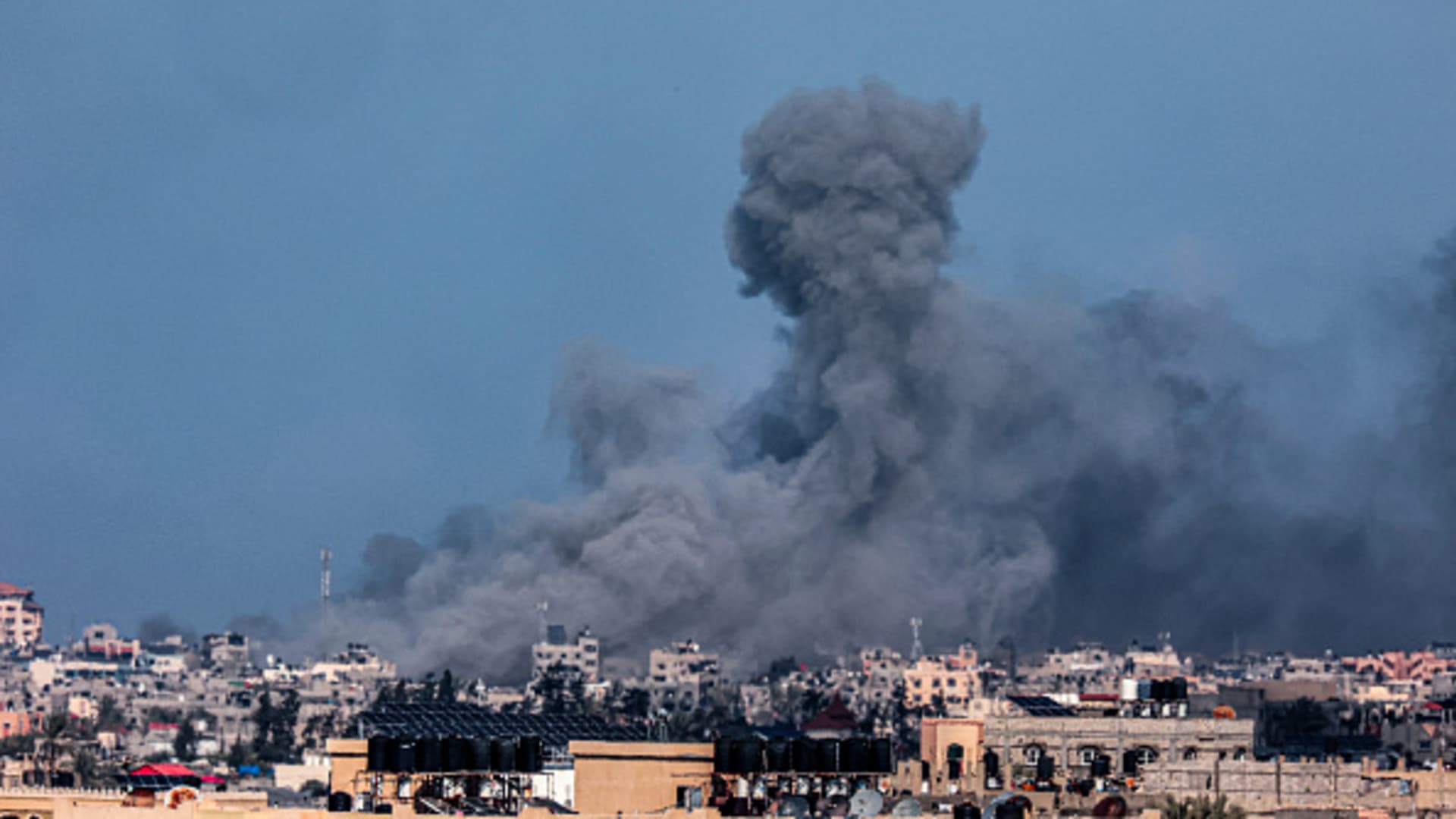A picture taken from Rafah shows smoke billowing during Israeli bombardment over Khan Yunis in the southern Gaza Strip on February 9, 2024, amid continuing battles between Israel and the Palestinian militant group Hamas.
Said Khatib | Afp | Getty Images
Trapped in and around Rafah, more than 1 million Palestinians braced for Israel to complete a plan to evacuate them and launch a ground assault against Hamas fighters in the southern Gaza city.
Aid agencies warned that large numbers of civilians could die in the Israeli offensive and the U.N. Palestinian refugee agency said it did not know how long it could work “in such a high risk operation.”
“There is a sense of growing anxiety, growing panic in Rafah,” said Philippe Lazzarini, the head of the UNRWA agency. “People have no idea where to go.”
Israeli Prime Minister Benjamin Netanyahu’s office on Friday announced that the military was ordered to develop a plan “for evacuating the population and destroying” four Hamas battalions that it said were deployed in Rafah.
Israel cannot achieve its goal of eliminating the Islamist militants who rule Gaza while those units remain, it said.
The statement, issued two days after Netanyahu rejected a Hamas ceasefire proposal that included the release of hostages held by the Palestinian militants, gave no further details.
Washington, Israel’s main supporter, said it would not back an assault that did not protect civilians, and had briefed Israel on a new U.S. national security memorandum reminding countries receiving U.S. arms to adhere to international law.
“There are no new standards in this memo. We are not imposing new standards for military aid,” White House press secretary Karine Jean-Pierre told reporters. “They (the Israelis) reiterated their willingness to provide these types of assurances.”
More than a million people driven southwards by more than four months of Israeli bombing of Gaza are packed into Rafah and surrounding areas on the coastal enclave’s border with Egypt, which has reinforced the frontier, fearing an exodus.
Doctors and aid workers are struggling to supply even basic aid to Palestinians sheltering around Rafah. Many are trapped against a border fence with Egypt and living in makeshift tents.
Israeli forces have been moving southwards towards the city after first storming northern Gaza in response to the Oct. 7 rampage into southern Israel by Hamas gunmen.
The United Nations said Palestinian civilians in Rafah require protection, but there should be no forced mass displacement, which is barred by international law.
“No war can be allowed in a gigantic refugee camp,” said Jan Egeland, secretary-general of the Norwegian Refugee Council, warning of a “bloodbath” if Israeli troops move into Rafah.
The Palestinian Presidency said Netanyahu’s plans aimed to displace the Palestinian people from their land.
“Taking this step threatens security and peace in the region and the world. It crosses all red lines,” said the office of Mahmoud Abbas, head of the Palestinian Authority that exerts partial self-rule in the Israeli-occupied West Bank.
An Israeli official who declined to be named said that Israel would try to organize for people in Rafah, most of whom fled there from the north, to be moved back northwards ahead of any assault.
Gaza’s health ministry said at least 27,947 Palestinians had been confirmed killed in the conflict and 67,459 injured. More could be buried under rubble.
Hamas gunmen killed some 1,200 people and took 253 hostages in the Oct. 7 rampage into southern Israel, according to Israeli tallies.
Almost one in 10 Gazans under the age of five are now acutely malnourished, according to initial U.N. data from arm measurements showing physical wasting.
The charity ActionAid said some Gazans were eating grass.
“Every single person in Gaza is now hungry, and people have just 1.5 to 2 litres of unsafe water per day to meet all their needs,” it said.
‘All were martyred’
Hours after Netanyahu’s statement, at least 11 Palestinians died in an Israeli airstrike on a house in Rafah, according to Hamas media outlets.
Reuters could not independently verify these accounts.
Earlier Israeli airstrikes killed at least 15 people, eight of them in the Rafah area, said Palestinian health officials.
“We were sleeping inside and, when the strike hit, were thrown outside,” said Mohammed al-Nahal, an elderly Palestinian standing beside the rubble of her stricken building.
“It destroyed the entire home. My daughter was killed. My daughter, her husband, her son, all were martyred.”
Israel’s military said its forces had been in action in the area of Khan Younis and in northern and central Gaza to eliminate militant cells and destroy militant infrastructure.
It says it takes steps to avoid civilian casualties and accuses Hamas militants of hiding among civilians, including at schools, shelters and hospitals. Hamas has denied doing so.
Hamas this week proposed a ceasefire of 4-1/2 months, during which remaining hostages would go free, Israeli troops would withdraw and agreement would be reached on ending the war.
Netanyahu rejected as “delusional” Hamas’ terms, a response to a plan developed by the U.S. and Israeli spy chiefs with Qatar and Egypt.





















Discussion about this post